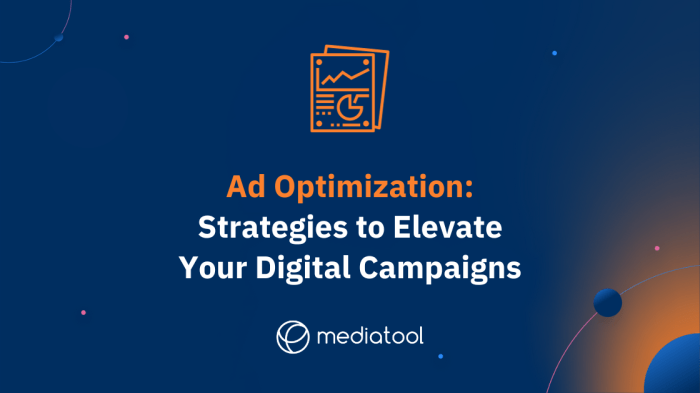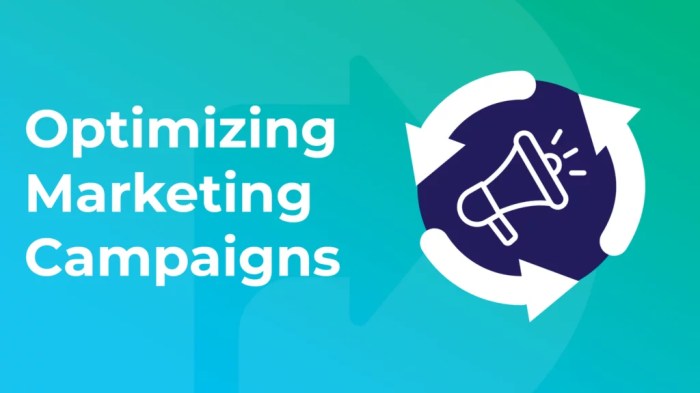Kicking off with Optimizing Ad Campaigns, get ready to dive into the world of boosting your marketing efforts to the max. From understanding ad campaign optimization to targeting the right audience and testing your ad copy, this guide will equip you with the tools needed to dominate the digital advertising game.
Are you ready to take your ad campaigns to the next level? Let’s optimize and conquer!
Understanding Ad Campaign Optimization
Ad campaign optimization is like tuning up a sweet ride but for businesses, ya dig? It’s all about making those ads work smarter, not harder. By tweaking and fine-tuning the campaign, you can maximize your results and get the most bang for your buck, baby.
Yo, managing time effectively is crucial for high school students to balance school, extracurricular activities, and chill time with friends. Check out this dope article on Effective Time Management to learn some tips and tricks to stay on top of your game!
Key Performance Indicators (KPIs)
When it comes to measuring ad campaign success, there are a few key metrics to keep an eye on, like:
- Click-Through Rate (CTR): This tells you how many peeps are clicking on your ad compared to how many peeps are seeing it. Higher CTR usually means more interest in your biz.
- Conversion Rate: This shows you how many peeps are taking action after clicking on your ad, like making a purchase or signing up. It’s all about that follow-through, baby.
- Return on Ad Spend (ROAS): This little number tells you how much moolah you’re making for every dollar you’re spending on ads. The higher the ROAS, the happier your wallet will be, ya feel?
Target Audience Analysis

Understanding the target audience is crucial when optimizing ad campaigns as it helps in crafting messages that resonate with the right people, leading to better engagement and conversion rates.Demographics and psychographics play a significant role in ad targeting decisions. Demographics include factors like age, gender, income, and location, providing basic information about the audience. On the other hand, psychographics delve deeper into the audience’s interests, values, attitudes, and behaviors, offering insights into their motivations and preferences.
Yo, time management is key, fam! You gotta stay on top of your game and make every minute count. Check out this dope link on Effective Time Management for some tips and tricks to help you stay organized and crush it in school and beyond. Don’t sleep on this, homie!
Segmenting and Targeting Strategies
- Utilize data analytics tools to gather and analyze demographic and psychographic information about your audience.
- Create buyer personas based on the collected data to represent different segments of your target audience.
- Develop tailored ad content and messages that speak to the specific needs and interests of each audience segment.
- Use A/B testing to experiment with different targeting strategies and optimize ad performance based on the results.
- Continuously monitor and adjust your targeting approach to ensure relevance and effectiveness in reaching your target audience.
Ad Copy and Creative Testing

When it comes to optimizing ad campaigns, testing different ad copies and creatives is crucial for maximizing performance and reaching the target audience effectively.
Significance of A/B Testing
A/B testing allows marketers to compare two different versions of an ad to see which one performs better. By testing variations in ad copy and creatives, businesses can understand what resonates with their audience and make data-driven decisions to improve campaign effectiveness.
- Set clear objectives for the test to determine what specific metrics you want to improve, such as click-through rates or conversions.
- Create variations of your ad copy or creative elements to test against each other, making sure to change only one element at a time for accurate results.
- Run the test simultaneously to minimize external factors that could skew the results, and make sure to have a large enough sample size for statistically significant findings.
- Analyze the data collected from the test to identify which version performed better and draw conclusions on what elements contributed to the success or failure of each variation.
Interpreting Test Results and Implementing Changes
After conducting ad copy and creative tests, it’s essential to interpret the results accurately and implement changes based on the findings to optimize future campaigns.
- Look at key performance indicators (KPIs) such as click-through rates, conversion rates, and engagement metrics to determine which version of the ad performed better.
- Identify patterns or trends in the data to understand what elements of the ad copy or creatives resonated with the target audience.
- Make data-driven decisions on which elements to keep, modify, or eliminate in future campaigns based on the test results to continuously improve ad performance.
Budget Allocation and Bid Strategy: Optimizing Ad Campaigns
When it comes to maximizing ad campaign performance, budget allocation plays a crucial role in determining how effectively your ads reach your target audience. Properly distributing your budget across different channels and campaigns can help optimize ad delivery and improve overall campaign results.
Different Bidding Strategies
- Manual Bidding: In this strategy, advertisers manually set the maximum bid they are willing to pay for a click or conversion. This gives them more control over their spending but requires constant monitoring and adjustments.
- Automated Bidding: With automated bidding, the advertising platform’s algorithm automatically adjusts bids based on the likelihood of conversion. This can save time and optimize performance based on real-time data.
- Target CPA Bidding: This strategy focuses on achieving a specific cost-per-acquisition (CPA) goal. The platform adjusts bids to meet the desired CPA while maximizing conversions.
Best Practices for Optimizing Budget Allocation, Optimizing Ad Campaigns
- Define Clear Campaign Goals: Understand what you want to achieve with your ad campaign before allocating budget. Whether it’s brand awareness, lead generation, or sales, align your budget with your objectives.
- Monitor Performance Regularly: Keep track of key metrics such as click-through rates, conversion rates, and return on ad spend (ROAS) to identify underperforming campaigns and reallocate budget accordingly.
- Test Different Strategies: Experiment with various bidding strategies and budget allocations to find the optimal combination that delivers the best results for your specific campaign goals.
- Consider Seasonality: Adjust your budget allocation based on seasonal trends and fluctuations in demand to ensure your ads are reaching the right audience at the right time.
